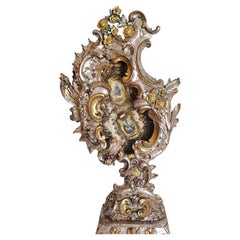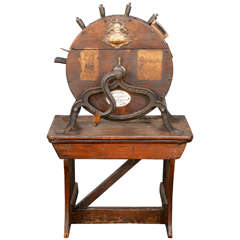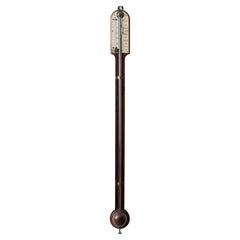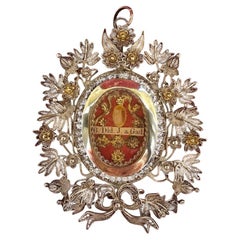Villa Melrose Collectibles and Curiosities
to
2
2
1
2
2
1
1
1
1
2
1
1
1
2
2
2
19th Century Carved Giltwood Reliquary
Located in Los Angeles, CA
Finely carved and detailed with a mix of silver and gold leaf together. Overall width is 18.5" Dated and signed on back side.
Category
Antique 19th Century Austrian Neoclassical Religious Items
Materials
Giltwood
19th Century English Knife Sharpener
Located in Los Angeles, CA
19th c. English Knife Sharpener in Oak and Pine
Category
Antique 19th Century English More Furniture and Collectibles
Materials
Oak, Pine
Related Items
English Stick Barometer by Loftus, London, 19th Century
Located in Savannah, GA
A late 19th century rosewood stick barometer by Loftus of London.
3 ¼ inches wide by 36 inches tall; 3 inches deep
Category
Antique 19th Century English Scientific Instruments
Materials
Rosewood
Gilt Silver Reliquary – 19th Century
Located in Madrid, ES
Interesting religious reliquary in gilt solid silver filigree, dating from the 19th century. This is a piece of exquisite craftsmanship, featuring an openwork design of plant motifs ...
Category
Antique 19th Century Spanish Romantic Religious Items
Materials
Silver
Rare 19th Century English Tunbridgeware Hair Pin or Slide
Located in Dallas, TX
PRESENTING an EXTREMELY UNIQUE and RARE 19C British Tunbridgeware Hair Pin/Bobbin or Slide.
This slide is unlike any of it’s kind we have seen before, it is a VERY RARE survivor.
From circa 1860 – 80 and made in Tunbridge Wells, England.
Made of walnut with gorgeous marquetry inlay on the entirety of the front with classic Tunbridgeware micro-mosaic all over the front. The rear is walnut.
The marquetry inlay appears to be various different woods, namely, maple, walnut and satinwood.
Would have been worn in a Lady’s hair bun with the micro-mosaic facing forward.
This would have belonged to a VERY ELEGANT LADY in the mid to late 19th Century.
Tunbridge ware is a form of decoratively inlaid woodwork, typically in the form of boxes, that is characteristic of Tonbridge and the spa town of Royal Tunbridge Wells in Kent in the 18th and 19th centuries. The decoration typically consists of a mosaic of many very small pieces of different coloured woods that form a pictorial vignette. Shaped rods and slivers of wood were first carefully glued together, then cut into many thin slices of identical pictorial veneer with a fine saw. Elaborately striped and feathered bandings for framing were pre-formed in a similar fashion.
There is a collection of Tunbridge ware in the Tunbridge Wells Museum and Art Gallery in Tunbridge Wells.
The famous makers of Tunbridge ware were in the Tunbridge Wells area of Kent; their most notable work was from circa 1830-1900.
Early makers of Tunbridge ware, in Tunbridge Wells in the mid-18th century, were the Burrows family, and Fenner and Co. In the 19th century, around 1830, James Burrows invented a technique of creating mosaics from wooden tesserae. Henry Hollamby, apprenticed to the Burrows family, set up on his own in 1842 and became an important manufacturer of Tunbridge ware, employing about 40 people.
Edmund Nye (1797–1863) and his father took over the Fenner company when William Fenner retired in 1840, after 30 years in partnership with him. Thomas Barton (1819–1903), previously apprenticed at the Wise factory, joined the Nyes in 1836, and worked as Nye’s designer; he took over the business in 1863 and continued there until his death.
In Tonbridge (near to Tunbridge Wells), George Wise (1703–1779) is known to have had a business in 1746. It continued with his son Thomas, and Thomas’s nephew George (1779–1869), who took over in 1806. In its early years the company made articles such as workboxes and tea caddies with prints of popular views; later items had pictures created from mosaics. Their workshop in Tonbridge, Wise’s Tunbridge Ware Manufactory, was next to the Big Bridge over the Medway; the building was demolished in 1886 to widen the approach to the bridge.
Tunbridge ware became popular with visitors to the spa town of Tunbridge Wells, who bought them as souvenirs and gifts. Articles included cribbage boards, paperweights, writing slopes, snuffboxes and glove boxes.
At the Great Exhibition of 1851, Tunbridge ware by Edmund Nye, Robert Russell and Henry Hollamby was shown; Edmund Nye received a commendation from the judges for his work. He exhibited a table depicting a mosaic of a ship at sea; 110,800 tesserae were used in making the picture.
The manufacturers of Tunbridge ware were cottage industries, and they were no more than nine in Tunbridge Wells and one in Tonbridge. The number declined in the 1880s; competent craftsmen were hard to find, and public tastes changed. After the death of Thomas Barton in 1903 the only surviving firm was Boyce, Brown and Kemp, which closed in 1927.
Marquetry was an old technique which was continued by Nye and Barton to create images such as birds or butterflies.
‘Green Oak’ as caused by the fungus Chlorociboria aeruginascens.
Stickware and half-square mosaic was invented by James Burrows in about 1830: a bunch of wooden sticks of different colours, each having triangular or diamond-shaped cross section, were tightly glued together; in the case of stickware, the resulting block was dried, then turned to form an article such as the base of a pincushion. For half-square mosaic, thin slices were taken from the composite block, and applied to a surface.
Tesselated mosaic, was a development by James Burrows of half-square mosaic; it was adopted by George Wise and Edmund Nye. Minute tesserae were used to form a wide variety of geometric and pictorial designs.
Many sorts of wood were used for the various colours; about 40 were in regular use. Only natural colors were used; green was provided by “green oak”, produced by the action of fungus on fallen oak. Designs for articles were often taken from designs of Berlin wool work.
Category
Antique Late 19th Century English High Victorian Collectible Jewelry
Materials
Satinwood, Walnut
19th Century English Folk Art Encased Ship Diorama
Located in London, GB
19th Century Folk Art Encased Ship Diorama
A delightful and highly decorated example of a late 19th century English folk art ships model diorama...
Category
Antique 19th Century British Folk Art Nautical Objects
Materials
Glass, Wood
A Rare Knife Sharpener From the Late 18/19th Century
Located in Madrid, ES
A rare knife sharpener from the late 18th century.
English,
iron and wood, by "Warren's Rotary."
Minor defects.
Dimensions: 44 x 54 x 25 cm
Good condition
Category
Antique Late 18th Century English Art Deco Models and Miniatures
Materials
Wood
19th c. Giltwood Barometer
Located in New Orleans, LA
Carved and Giltwood Louis XVI Style Barometer
Category
Antique 19th Century French Scientific Instruments
Materials
Giltwood
Pair of 19th C. Italian Reliquaries
Located in Los Angeles, CA
19th century pair of ornate gilded relicquaries made of brass with a gilt finish.
The feature highly decorative Baroque or Rococo-style detailing, including intricate scrollwork, f...
Category
Antique 19th Century Italian Baroque Religious Items
Materials
Brass
Mid-19th Century French Carved Giltwood and Polychromed Virgin Mary Statue
Located in Dallas, TX
This beautiful, antique sculpture of the Virgin Mary in prayers was created in Pyrenees of France, circa 1860. Embellished with gold leaf and polychrome finish, the Classic religious...
Category
Antique Mid-19th Century French Religious Items
Materials
Giltwood
$2,975
H 22 in W 8 in D 7 in
Early 19th Century Giltwood Barometer "Selon Toricelli"
Located in Madrid, ES
Barometer end of the 18th century, Directorie, in carved and gilded wood, by Selon Toriceli, with allegory music wing on the top, beautiful patina, and decorative barometer...
Category
Antique 19th Century French Directoire Scientific Instruments
Materials
Wood
$1,779 Sale Price
48% Off
H 35.44 in W 15.75 in D 1.7 in
Pair of Late 19th Century English Riding Boots
Located in Chicago, IL
This striking pair of late 19th-century English black leather riding boots is a handsome relic of the sporting life. Crafted with exceptional care, the boots retain their original fo...
Category
Antique Late 19th Century English Edwardian Sports Equipment and Memorab...
Materials
Leather, Wood
Late 19th Century English Diorama Clipper Ship Shadowbox
Located in Queens, NY
Late 19th century English Victorian painted diorama wall plaque of clipper ship with red flag painted in cloudy sky in mahogany frame.
Category
Antique Late 19th Century British Victorian Nautical Objects
Materials
Mahogany
19th Century Italian Carved Louis XVI Style Giltwood Barometer
Located in Rio Vista, CA
Gorgeous late 19th century gilt wood barometer thermometer made in Italy in the Louis XVI or baroque taste. The large barometer features a large carve...
Category
Antique 19th Century Italian Louis XVI Scientific Instruments
Materials
Metal, Brass



